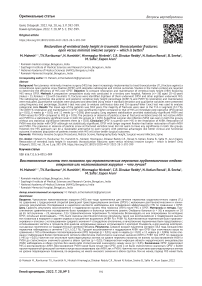Restoration of vertebral body height in traumatic thoracolumbar fractures: open versus minimal invasive surgery - which is better?
Автор: Mahesh M., Ravikumar T.V., Harshith N., Nirdesh Hiremaglur, Dinakar Reddy C.R., Ronak Kotian N., Sneha B., Safia M., Arun Eapen
Журнал: Гений ортопедии @geniy-ortopedii
Рубрика: Оригинальные статьи
Статья в выпуске: 3 т.28, 2022 года.
Бесплатный доступ
Background Percutaneous minimally invasive surgery (MIS) has been increasingly implemented to treat thoracolumbar (TL) fracture against a conventional open pedicle screw fixation (OPSF) with desirable radiological and clinical outcomes. Studies in the Indian context are required to determine the efficiency of MIS over OPSF. Objective To compare restoration and maintenance of vertebral body height (VBH) following MIS versus OPSF. Methods A prospective comparative study was conducted in a tertiary care hospital. Patients (n = 36) aged 18-65 years (males = 23, females = 13) with traumatic TL fractures were identified. Eighteen of them underwent OPSF and other eighteen underwent MIS. The radiological outcomes like anterior and posterior vertebral body height percentage (AVBH % and PVBH %) restoration and maintenance were evaluated. Quantitative variables were analyzed and described using mean ± standard deviation and qualitative variables were presented using frequency and percentage. Student t-test was used to analyse continuous data and Chi-square/Fisher Exact test was used to analyse categorical data. Results The mean age of the patients was 38.8 years. The majority of fractures were seen in the T12-LI segment (52.7 %). The AVBH % restoration and maintenance in OPSF was significantly higher compared to that of MIS at immediate post-operative (IPO) period (p = 0.01), 6 weeks (p = 0.02) and 12 weeks (p = 0.006) post-surgery. Long segment stabilization provided statistically significant AVBH and PVBH values for OPSF compared to MIS (p 0.05). Superficial surgical site infection (SSSI) was seen in both the groups without any statistical significance between them (p > 0.05). Conclusion OPSF is superior over MIS in the restoration of AVBH. Restoration of PVBH was also better with OPSF although not statistically significant. OPSF with longer segment fixation had better restoration of both AVBH and PVBH. The presence or absence of pedicle screw at fractured vertebral level did not seem to have any significance in both the groups. However, the MIS approach can be a reasonable alternative to open surgery with potential advantages like better clinical and functional outcome. A selected population of patients treated with MIS will show better surgical outcomes.
Minimally invasive surgical procedures, pedicle screws, radiography, body height, surgical wound infection, spine
Короткий адрес: https://sciup.org/142235339
IDR: 142235339 | УДК: 616.711.5/.6-001.5-089 | DOI: 10.18019/1028-4427-2022-28-3-392-399
Текст научной статьи Restoration of vertebral body height in traumatic thoracolumbar fractures: open versus minimal invasive surgery - which is better?
Original article
Thoracolumbar (TL) fractures constitute a large spectrum of musculoskeletal injuries ranging from a simple non-displaced fracture to a complex fracturedislocation [1]. Most TL injuries occur at the T11 to L2 level [2]. Around 50 % of these injuries are unstable and may lead to deformity, disability, neurological deficits that disrupt the quality of life [1]. The causes of TL fracture may vary based on the patient’s age. The most common cause in young individuals is high-energy trauma and plunge from a height [1]. Low-energy trauma is the most common cause of osteoporotic fracture in the elderly [3].
Conventional open pedicle screw fixation (OPSF) via posterior approach has been the gold standard surgical method in the treatment of traumatic TL fractures [4]. However, the open technique involves extensive exposure and is associated with postoperative pain as well as early morbidity [1]. The percutaneous minimally invasive surgery (MIS) to treat TL fractures has gained much attention with good radiological and clinical outcomes [5, 6]. The restoration of AVBH and PVBH are the most important radiological parameters assessed following the fixation of TL spine. Pedicle screw fixation through in MIS via the Wiltse approach for the treatment of TL fractures efficiently restores the spine curvature, rebuilds the vertebral body height (VBH), resets the fracture blocks, and achieves threedimensional fixation without morbidity [4, 7].
Although MIS is an attractive alternative to open surgery, it is still unclear whether MIS restores the VBH comparable to OPSF. Hence, the present study intended to compare the outcomes of MIS versus OPSF with regards to restoration and maintenance of AVBH and PVBH.
Subjects and Methods
This prospective comparative study was conducted on patients admitted to the department of orthopaedics in a tertiary care hospital with traumatic TL fractures from 2016 to 2018. Inclusion criteria were patients aged 18–65 years with traumatic TL fractures. All the patients with absent neurological deficits and those under AO subtypes A1–A4 and B1 were included. Patients with osteoporotic fractures, pathological fractures due to primary tumour/ metastasis, and previous surgery at the site of fracture were excluded. Patients who fulfilled the inclusion criteria were explained clearly about the purpose and nature of the study and written their informed consent was obtained. Ethical clearance was sought from Institutional Ethical and Review board before the study commencement.
The diagnosis of traumatic TL fractures was made based on clinical and radiological evaluation. Basic radiological examinations included antero-posterior and lateral radiographs of the fractured vertebra, Magnetic Resonance Imaging (MRI) of the fractured vertebra +/-Computed Tomography (CT) were done. OPSF for the fractured vertebra was performed in one group (n = 18) and
MIS in the other group (n = 18). All patients underwent the procedure in prone position on Wilson’s frame, with the hip and knee in extension – indirectly flexing the pelvis, increasing the lumbar lordosis and thoracic kyphosis, thereby helping in ligamentotaxis and reduction of the fracture. The incision was made centering over the level of injury, and two levels, above and below the injury, were exposed. Without performing laminectomy, the pedicle screws were put in anatomical position, cantilevering of the rod along with sequential distraction and compression between the tulip of the pedicle screws were done to achieve indirect reduction and restoration of the VBH. The postoperative radiological examination was done at followed-ups for a minimum period of 12 weeks.
Patients were evaluated in the immediate postoperative (IPO) period, and at follow-up after weeks 6 and 12. Radiological parameters measured were AVBH and PVBH on lateral radiographs of the spine preoperatively, IPO period and later at 6 and 12 weeks post-operatively. Any complications following two different surgical techniques were followed up and noted. VBH loss was measured using the Anterior Vertebral Body Compression Percentage (AVBC %), consisting of the percentage of anterior vertebral body compression with respect to the average height of the anterior vertebral bodies immediately, cephalad and caudal to the injury level (formula: V2 / [(V1 + V3)/2] × 100 %) [9].
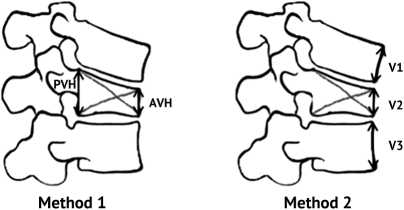
Method 1 = Ante ri о r/M id die Column Vertebral Body Compression Ratio (VBCR) = AVH/PVH Method 2 = Anterior Vertebral Body Compression Percentage (AVBC%) = V2/[(Vl+V3)/2]x100%) AVH = anterior vertebral height
PVH = posterior vertebral height
Fig. 1. Surveyed measurement techniques for assessing vertebral body height loss [9]
Statistical analysis
All the quantitative variables were analyzed and described using mean ± standard deviation. All the qualitative variables were presented using frequency and percentage. Student t-test was used to find the significance of study parameters on a continuous scale between two groups. Chi-square/Fisher Exact test was used to find the significance of study parameters on a categorical scale between two or more groups. Fisher Exact test was used when sample were very small.
RESULTS
The mean age of patients in the OPSF group was younger when compared to patients in the MIS group, with male predominance in both the groups (P = 0.34). Most patients in both groups were diagnosed with a vertebral fracture of T12, followed by L1 and L2. Pedicle screws were inserted at the fracture site in most patients of both the groups. No significant difference was found between both groups with respect to sex, age, injury level, number of levels stabilized, and insertion of screw (P > 0.05; Table 1).
Table 1
Demography and clinical characteristics in each group
|
Characteristics |
Group OPSF (n = 18) |
Group MIS (n = 18) |
P-value |
|
|
Age |
37.94 ± 11.37 |
39.67 ± 12.14 |
0.34 |
|
|
Sex |
Female |
6 (33.33 %) |
7 (38.89 %) |
0.72 |
|
Male |
12 (66.67 %) |
11 (61.11 %) |
||
|
Injured level |
L1 |
5(27.8 %) |
4(22.2 %) |
0.60 |
|
L2 |
4(22.2 %) |
2(11.1 %) |
||
|
L3 |
3(16.7 %) |
1(5.6 %) |
||
|
L4 |
0(0 %) |
1(5.6 %) |
||
|
T12 |
4(22.2 %) |
6(33.3 %) |
||
|
T11 |
2(11.1 %) |
1(5.6 %) |
||
|
T10 |
0(0 %) |
1(5.6 %) |
||
|
T8 |
0(0 %) |
1(5.6 %) |
||
|
T5 |
0(0 %) |
1(5.6 %) |
||
|
Number of level stabilized |
3 |
8 (44.44 %) |
10 (55.56 %) |
0.50 |
|
5 |
10 (55.56 %) |
8 (44.44 %) |
||
|
Screw at fracture site |
No |
8 (44.44 %) |
8 (44.44 %) |
1 |
|
Yes |
10 (55.56 %) |
10 (55.56 %) |
||
Notes : MIS – minimally invasive surgery; AVBH – anterior vertebral body height; PVBH – posterior vertebral body height
In the IPO period and at follow-up weeks 6 and 12, both AVBH and percentage AVBH restoration were significantly increased in the OPSF group compared to MIS group; PVBH and the percentage restoration of PVBH was also higher in the OPSF group compared to the MIS group, however, not statistically significant. The major complication in open surgery group was SSSI (11.1 %), whereas implant failure (11.1 %) in the MIS group. Although insignificant, post-surgical complications were fewer in the open surgery group as compared to the MIS group (P > 0.05; Table 2).
The percentage of AVBH and PVBH restoration in the IPO period, at weeks 6 and 12 compared with regards to number of levels stabilized is given in Table 3 and Figures 2–4. The percentage of restoration of AVBH and PVBH in longer segment fixation (5 levels) at IPO period, weeks 6 and 12 was statistically significant in the OPSF group. However, percentage restoration of AVBH in the MIS group was higher in short segment fixation at IPO period, 6 weeks, and 12 weeks although not statistically significant (Table 3) whereas percentage restoration of PVBH at IPO period, 6 weeks, and 12 weeks was higher in long segment fixation, although not statistically significant when comparing short and long segment fixation.
Table 2
Comparison of AVBH, PVBH, restoration of AVBH, restoration of PVBH, complications in both groups after surgery
|
Characteristics |
OPSF |
MIS |
P-value |
|
|
AVBH |
Pre-operation |
67.84 ± 7.59 |
69.45 ± 11.63 |
0.71 |
|
IPO period |
82.01 ± 7.43 |
78.92 ± 9.92 |
0.01* |
|
|
6 weeks |
80.19 ± 7.50 |
77.7 ± 9.81 |
0.04* |
|
|
12 weeks |
79.15 ± 7.32 |
76.68 ± 9.81 |
0.04* |
|
|
% Restoration of AVBH |
Post-op |
14.17 ± 5.48 |
9.48 ± 5.13 |
0.01* |
|
6 weeks |
12.38 ± 4.95 |
8.25 ± 4.95 |
0.02* |
|
|
12 weeks |
11.31 ± 4.62 |
7.24 ± 4.70 |
0.006** |
|
|
PVBH |
Pre-op |
93.17 ± 4.32 |
92.97 ± 2.47 |
0.56 |
|
Post-op |
95.61 ± 3.02 |
95.18 ± 2.53 |
0.79 |
|
|
6 weeks |
95.14 ± 3.41 |
94.70 ± 2.35 |
0.06 |
|
|
12 weeks |
94.95 ± 3.46 |
94.51 ± 2.39 |
0.12 |
|
|
% Restoration of PVBH |
Post-op |
2.44 ± 2.21 |
2.21 ± 1.76 |
0.74 |
|
6 weeks |
1.97 ± 1.75 |
1.73 ± 1.22 |
0.85 |
|
|
12 weeks |
1.78 ± 1.57 |
1.54 ± 1.14 |
0.15 |
|
|
Complications |
No |
16 (88.89 %) |
15 (83.33 %) |
0.31 |
|
Implant failure |
0 |
2 (11.11 %) |
||
|
SSSIs |
2 (11.11 %) |
1 (5.56 %) |
||
Notes : MIS – minimally invasive surgery; AVBH – anterior vertebral body height; PVBH – posterior vertebral body height
Table 3
Number of levels stabilized with % restoration (AVBH and PVBH) in both groups
|
Group |
% restoration |
Number of levels stabilized |
P-value |
|
|
3 |
5 |
|||
|
OPSF |
AVBH |
|||
|
IPO period |
11.13 ± 1.98 |
16.61 ± 6.24 |
0.000*** |
|
|
6 weeks |
10.22 ± 2.96 |
14.11 ± 5.67 |
0.000*** |
|
|
12 weeks |
9.34 ± 2.87 |
12.88 ± 5.27 |
0.015* |
|
|
PVBH |
||||
|
IPO period |
0.93 ± 1.25 |
3.64 ± 2.09 |
0.000*** |
|
|
6 weeks |
0.87 ± 1.24 |
2.85 ± 1.64 |
0.010* |
|
|
12 weeks |
0.78 ± 1.08 |
2.58 ± 1.47 |
0.000*** |
|
|
MIS |
AVBH |
|||
|
IPO period |
10.33 ± 5.62 |
8.43 ± 4.58 |
0.98 |
|
|
6 weeks |
8.93 ± 5.56 |
7.41 ± 4.25 |
0.97 |
|
|
12 weeks |
7.79 ± 5.19 |
6.53 ± 4.25 |
0.68 |
|
|
PVBH |
||||
|
IPO period |
1.97 ± 1.11 |
2.51 ± 2.39 |
0.27 |
|
|
6 weeks |
1.57 ± 0.79 |
1.95 ± 1.64 |
0.16 |
|
|
12 weeks |
1.38 ± 0.73 |
1.64 ± 1.55 |
0.08 |
|
Notes : MIS – minimally invasive surgery; AVBH – anterior vertebral body height; PVBH – posterior vertebral body height
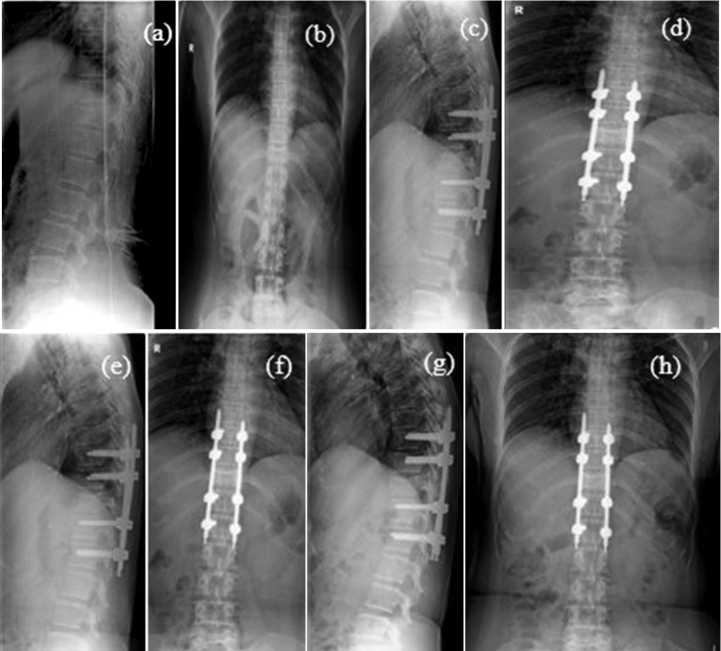
Fig. 2. X-rays of a 49-year old female patient with T11 fracture who underwent T9-L1 MIS 5 level stabilization without screw at fracture site: pre-operative AVBH and PVBH (a, b); IPO AVBH and PVBH (c, d); post-operative AVBH and PVBH at 6 weeks (e, f), and at 12 weeks (g, h)
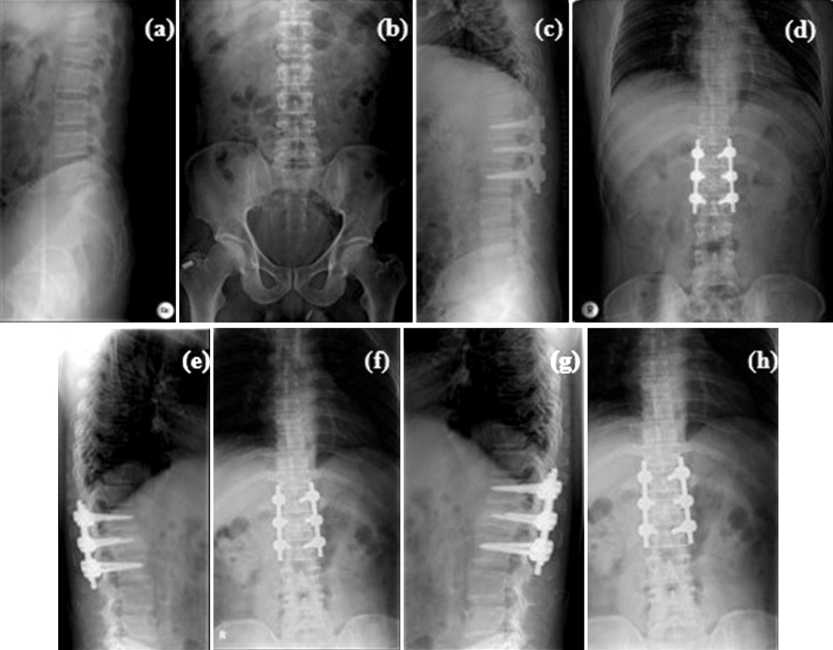
Fig. 3. X-rays of a 58-year old female patient with L1 fracture who underwent T12-L2 open 3 level surgery with screw stabilization fracture site: pre-operative AVBH and PVBH (a, b); IPO AVBH and PVBH (c, d); post-operative AVBH and PVBH at 6 weeks (e, f), and at 12 weeks (g, h)
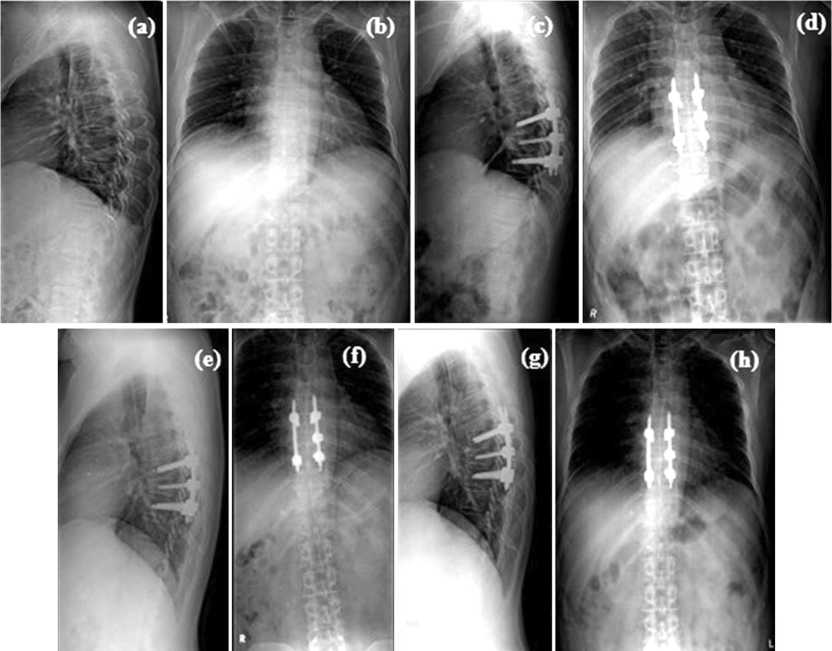
Fig. 4. X-rays of a 42-year old female patient with T8 fracture who underwent T7-T9 MIS 3 level stabilization with screw at fracture: preoperative anterior vertebral body height and PVBH (a, b); IPO AVBH and PVBH (c, d); post-operative AVBH and PVBH at 6 weeks (e, f) and, at 12 weeks (g, h)
The percentage restoration of AVBH and PVBH at IPO period, 6 weeks, and 12 weeks compared with regards to the presence or absence of screw at the fractured vertebral level in both groups is tabulated in Table 4. The percentage restoration of AVBH was higher in patients with a screw at the fractured vertebral level compared to patients without a screw in both OPSF and MIS groups, although not statistically significant. The percentage restoration of PVBH was higher in patients without a screw at fractured vertebral level in both groups (Table 4), although not statistically significant (Fig. 5–9).
A 23-year-old male patient (Fig. 5) with T12 fracture: T10-L2 open surgery with 5-level stabilization without screw fixation at the fracture site was done (Fig. 6). Pre-operative AVBH (Fig. 6, a) (in millimeter) = 12/(26.3+26.9)/2 = 12/26.6 = 45.11 %. Pre-operative PVBH (Fig. 6, b) (in millimeter) = 25.8/(26.2+28.3)/2 = 25.8/27.25 = 94.67 %. Post-operative AVBH: 25/26.6 = 93.98 % (Fig. 7, b), or 48.87 % restoration compared to preoperative AVBH; postoperative PVBH 26.8/27.25 = 98.34, or 3.67 % restoration compared to preoperative PVBH. Post-operative X-rays AP and lateral views (Fig. 7). Post-operative AVBH at 6 weeks (Fig. 8): 24.7/26.6 = 92.85 %, or 47.74 % restoration compared to preoperative AVBH; post-operative PVBH at 6 weeks: 26.8/27.25 = 98.34 %, or 3.67 % restoration compared to preoperative PVBH; 6 weeks post-operative X-rays AP and lateral views (Fig. 8, a, c). 12-weeks postoperative AVBH: 24.7/26.6 = 92.85 %, or 47.74 % restoration compared to preoperative AVBH (Fig. 9, b); 12-weeks post- operative PVBH: 26.8/27.25 = 98.34, or 3.67 % restoration compared to preoperative PVBH; 12-weeks post-operative X-rays AP and lateral views (Fig. 9, a, c).
Table 4
Screw at fracture site with % restoration (AVBH and PVBH) in each group (OPSF and MIS)
|
Group |
% Restoration |
Screw at fracture site |
P-value |
|
|
No |
Yes |
|||
|
OPSF |
AVBH |
|||
|
IPO period |
14.43 ± 6.01 |
13.96 ± 5.34 |
0.75 |
|
|
6 weeks |
12.35 ± 5.75 |
12.40 ± 4.54 |
0.34 |
|
|
12 weeks |
11.18 ± 5.49 |
11.42 ± 4.12 |
0.90 |
|
|
PVBH |
||||
|
IPO period |
3.18 ± 2.55 |
1.84 ± 1.81 |
0.05 |
|
|
6 weeks |
2.46 ± 1.93 |
1.58 ± 1.59 |
0.08 |
|
|
12 weeks |
2.18 ± 1.68 |
1.46 ± 1.48 |
0.47 |
|
|
MIS |
AVBH |
|||
|
IPO period |
8.03 ± 4.53 |
9.65 ± 5.51 |
0.19 |
|
|
6 weeks |
7.06 ± 4.95 |
8.21 ± 4.98 |
0.07 |
|
|
12 weeks |
5.92 ± 4.72 |
8.28 ± 4.66 |
0.51 |
|
|
PVBH |
||||
|
IPO period |
2.21 ± 2.03 |
2.22 ± 1.62 |
0.06 |
|
|
6 weeks |
1.77 ± 1.33 |
1.71 ± 1.19 |
0.94 |
|
|
12 weeks |
1.51 ± 1.22 |
1.57 ± 1.14 |
0.1474 |
|
Notes : MIS – minimally invasive surgery; AVBH – anterior vertebral body height; PVBH – posterior vertebral body height
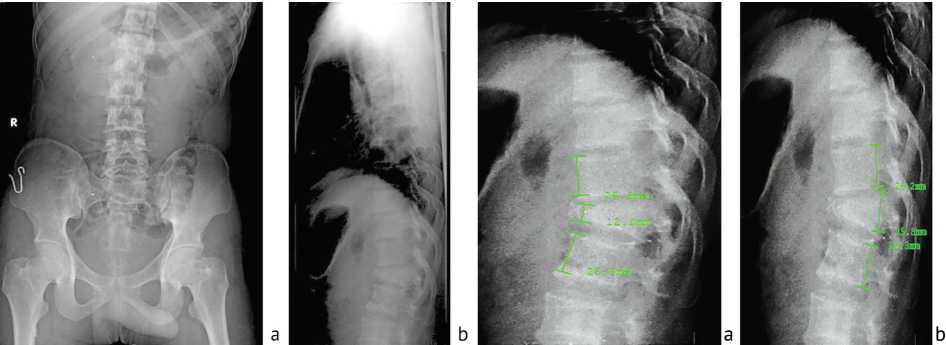
Fig. 5. Pre-operative AP (a) and lateral (b) X-rays of the patient
Fig. 6. Pre-operative AVBH (a) and PVBH (b) of the patient
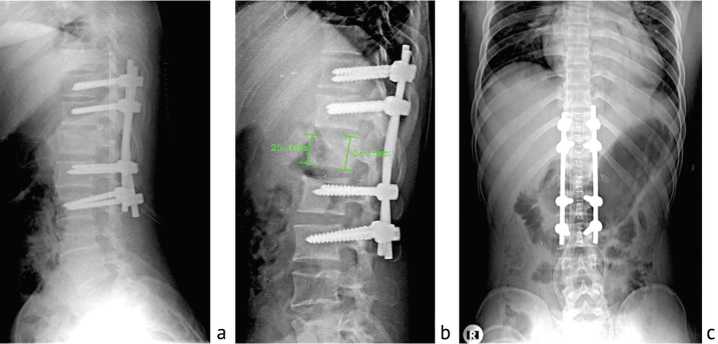
Fig. 7. IPO X-rays and AVBH and PVBH restoration of the patient
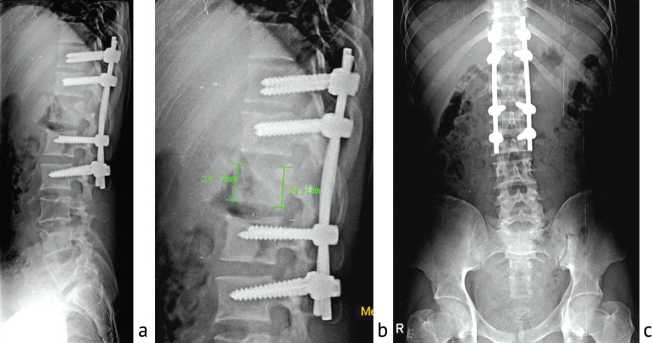
Fig. 8. 6-weeks post-operative X-rays and AVBH and PVBH restoration of the patient
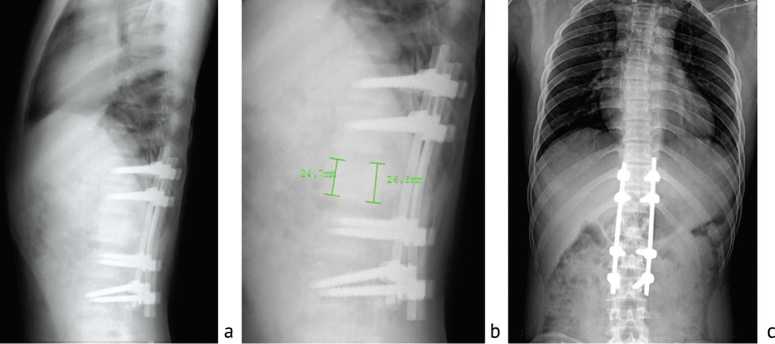
Fig. 9. 12-weeks post-operative X-rays and AVBH and PVBH restoration of the patient
DISCUSSION
The advent of MIS represents one of the most important advances in surgery during recent times. Compared to OPSF, the MIS has more advantages clinically such as reduced blood loss, operative time, hospital stay and rehabilitation with less soft tissue damage [2, 11]. Percentage restoration of VBH was comparable between MIS and OPSF in a previous study [13]. However, in the present study it was found that OPSF was better for VBH restoration especially with respect to AVBH restoration and maintenance when compared to percutaneous MIS. The technical limitation of MIS instruments currently available for maneuverability to restore the VBH, and with intact paraspinal muscle and soft tissue of the posterior column in MIS may hinder complete distraction of the anterior column.
The mean age of the patients was 38.8 years with male predominance (12:6 in the open surgery and 11:7 in MIS group). Similarly, Khurjekar et al [12] in their study reported a male to female ratio of 8:1 and the mean age of patients to be 32 years. High exposure of adult males to outdoor and physical activities is the reason behind the high incidence of thoracolumbar fractures in the male population. It has been well documented that being a biomechanically unstable segment, more than 50 % of fractures occur in T12-L1 region and similar findings were also observed in this study [12].
The present study demonstrates the advantages of OPSF over MIS in several aspects. AVBH and its percentage restoration was higher significantly in OPSF group when compared to MIS group in IPO period, at 6 and 12 weeks respectively when compared to their preoperative values. On the contrary, other studies have reported that both OPSF and MIS brought significant improvement in AVBH compared to pre-operative data [10, 13]. A retrospective study by Zhao et al. [14] reported that AVBH increased significantly post-operatively when compared to pre-operative levels and the loss of AVBH in the group with screw fixation at the fractured vertebra was significantly less than in the group without screw fixation at the fractured vertebra after one-year follow-up period with open approach. However, the presence or absence of pedicle screw at fractured vertebral level did not seem to have any difference in both the groups in our study.
Previous study [15] demonstrated that the percentage of AVBH restoration was better in the long segment than in the short segment, while a few other studies reported that both long and short segment fixations had similar outcomes in terms of post-operative pain relief [16,17]. In the present study, long segment stabilization (5 levels) gave better restoration and maintenance of both AVBH and PVBH in the OPSF group. The longer the segment of fixation, the longer is the lever arm for correction and hence it results in better restoration of VBH.
Previous studies reported that post-operative complications are fewer with the MIS approach than the conventional OPSF for TL fractures [18–20]. In this study, SSSI was the most common complication in both groups and, although statistically insignificant, two implant failures were seen in the MIS group.
Certainly, the study has a few limitations. First, we evaluated the AVBH and PVBH using standard radiographs. Computed tomography is the best modality to assess the AVBH and PVBH especially for post-operative assessment. Second, this was purely a radiological comparison and no functional outcome scores were assessed. Third, the study sample size was quite small with a short term of follow up. Hence studies with a larger sample size with long term follow-up are needed to validate the current findings, with specific number of participants for every fracture type.
CONCLUSIONS
-
1. OPSF is superior over MIS in the restoration of AVBH.
-
2. Restoration of PVBH was also better with OPSF, although not statistically significant.
-
3. OPSF with longer segment fixation had better restoration of both AVBH and PVBH whereas number of levels of fixation did not have any effect in the MIS group.
-
4. The presence or absence of pedicle screw at fractured vertebral level did not seem to have any difference in both the groups.
-
5. However, the MIS approach can be a reasonable alternative to open surgery with potential advantages like better clinical and functional outcomes. A selected population of patients treated with MIS might show better surgical outcomes.
-
6. RCTs or prospective cohort studies, which avoid selection and experimental bias and with controls for confounding factors, are necessary to adequately evaluate this question further before the routine application can be recommended.
Список литературы Restoration of vertebral body height in traumatic thoracolumbar fractures: open versus minimal invasive surgery - which is better?
- Rajasekaran S., Karma R.M., Shetty A.P. Management of thoracolumbar spine trauma: An overview // Indian J. Orthop. 2015. Vol. 49, No 1. P. 7282. DOI: 10.4103/0019-5413.143914.
- Open versus minimally invasive percutaneous surgery for surgical treatment of thoracolumbar spine fractures - a multicenter randomized controlled trial: study protocol / H.L.A. Defino, H.R.T. Costa, A.A. Nunes, M.N. Barbosa, V. Romero // BMC Musculoskelet. Disord. 2019. Vol. 20, No 1. P. 397. DOI: 10.1186/s12891-019-2763-1.
- The surgical treatment strategies for thoracolumbar spine fractures with ankylosing spondylitis: a case report / Y. Min, G. Hui-Yun, Z. Hou-Cheng, X. Yuan-Long, I. Wei, C. Lin, W. Ren-Xiong // BMC Surg. 2019. Vol. 19, No 1. P. 99. DOI: 10.1186/s12893-019-0565-x.
- Two different surgery approaches for treatment of thoracolumbar fracture / Z. Liu, Z. Li, D. Xing, H. Gao, C. Peng, M. Gong // Int. J. Clin. Exp. Med. 2015. Vol. 8, No 12. P. 22425-22429.
- Comparison of the effects of minimally invasive percutaneous pedicle screws osteosynthesis and open surgery on repairing the pain, inflammation and recovery of thoracolumbar vertebra fracture / Y. Gong, G. Fu, B. Li, Y. Li, X. Yang // Exp. Ther. Med. 2017. Vol. 14, No 5. P. 4091-4096. DOI: 10.3892/etm.2017.5036.
- Sun X.Y., Zhang X.N., Hai Y. Percutaneous versus traditional and paraspinal posterior open approaches for treatment of thoracolumbar fractures without neurologic deficit: a meta-analysis // Eur. Spine J. 2017. Vol. 26, No 5. P. 1418-1431. DOI: 10.1007/s00586-016-4818-4.
- A comparison of three different surgical procedures in the treatment of type A thoracolumbar fractures: a randomized controlled trial / J. Lyu, K. Chen, Z. Tang, Y. Chen, M. Li, Q. Zhang // Int. Orthop. 2016. Vol. 40, No 6. P. 1233-1238. DOI: 10.1007/s00264-016-3129-z.
- Minimally invasive reduction of thoracolumbar burst fracture using monoaxial percutaneous pedicle screws: Surgical technique and report of radiological outcome / W.H. Chung, W.C. Eu, C.K. Chiu, C.Y.W. Chan, M.K. Kwan // J. Orthop. Surg. (Hong Kong). 2020. Vol. 28, No 1. 2309499019888977. DOI: 10.1177/2309499019888977.
- Measurement of kyphosis and vertebral body height loss in traumatic spine fractures: an international study / S. Sadiqi, J.J. Verlaan, A.M. Lehr, J.R. Chapman, M.F. Dvorak, F. Kandziora, S. Rajasekaran, K.J. Schnake, A.R. Vaccaro, F.C. Oner // Eur. Spine J. 2017. Vol. 26, No 5. P. 1483-1491. DOI: 10.1007/s00586-016-4716-9.
- Surgical outcomes of mini-open Wiltse approach and conventional open approach in patients with single-segment thoracolumbar fractures without neurologic injury / H. Li, L. Yang, H. Xie, L. Yu, H. Wei, X. Cao // J. Biomed. Res. 2015. Vol. 29, No 1. P. 76-82. DOI: 10.7555/JBR.29.20140083.
- Kim B.G., Dan J.M., Shin D.E. Treatment of thoracolumbar fracture // Asian Spine J. 2015. Vol. 9, No 1. P. 133-146. DOI: 10.4184/asj.2015.9.1.133.
- Demographics of Thoracolumbar Fracture in Indian Population Presenting to a Tertiary Level Trauma Centre / K. Khurjekar, S. Hadgaonkar, A. Kothari, R. Raut, V. Krishnan, A. Shyam, P. Sancheti // Asian Spine J. 2015. Vol. 9, No 3. P. 344-351. DOI: 10.4184/asj.2015.9.3.344.
- Open versus Minimally Invasive Fixation Techniques for Thoracolumbar Trauma: A Meta-Analysis / S.J. McAnany, S.C. Overley, J.S. Kim, E.O. Baird, S.A. Qureshi, P.A. Anderson // Global Spine J. 2016. Vol. 6, No 2. P. 186-194. DOI: 10.1055/s-0035-1554777.
- Surgical outcome of posterior fixation, including fractured vertebra, for thoracolumbar fractures / Q.M. Zhao, X.F. Gu, H.L. Yang, Z.T. Liu // Neurosciences (Riyadh). 2015. Vol. 20, No 4. P. 362-367. DOI: 10.17712/nsj.2015.4.20150318.
- Tezeren G., Kuru I. Posterior fixation of thoracolumbar burst fracture: short-segment pedicle fixation versus long-segment instrumentation // J. Spinal Disord. Tech. 2005. Vol. 18, No 6. P. 485-488. DOI: 10.1097/01.bsd.0000149874.61397.38.
- Short-segment versus Long-segment Stabilization for Unstable Thoracolumbar Junction Burst Fractures / M.K. Ahsan, A.A. Mamun, Z. Zahangiri, M.A. Awwal, S.I. Khan, N. Zaman, M.H. Haque // Mymensingh Med. J. 2017. Vol. 26, No 4. P. 762-774.
- Aly T.A. Short segment versus long segment pedicle screws fixation in management of thoracolumbar burst fractures: meta-analysis // Asian Spine J. 2017. Vol. 11, No 1. P. 150-160. DOI: 10.4184/asj.2017.11.1.150.
- Phan K., Rao P.J., Mobbs R.J. Percutaneous versus open pedicle screw fixation for treatment of thoracolumbar fractures: systematic review and meta-analysis of comparative studies // Clin. Neurol. Neurosurg. 2015. Vol. 135. P. 85-92. DOI: 10.1016/j.clineuro.2015.05.016.
- Percutaneous augmented instrumentation of unstable thoracolumbar burst fractures / N. Rahamimov, H. Mulla, A. Shani, S. Freiman // Eur. Spine J. 2012. Vol. 21, No 5. P. 850-854. DOI: 10.1007/s00586-011-2106-x.
- Complications in minimally invasive percutaneous fixation of thoracic and lumbar spine fractures and tumors / A. Gasbarrini, M. Cappuccio, S. Colangeli, M.D. Posadas, R. Ghermandi, L. Amendola // Eur. Spine J. 2013. Vol. 22, No Suppl. 6. P. S965-S971. DOI: 10.1007/s00586-013-3019-7.

